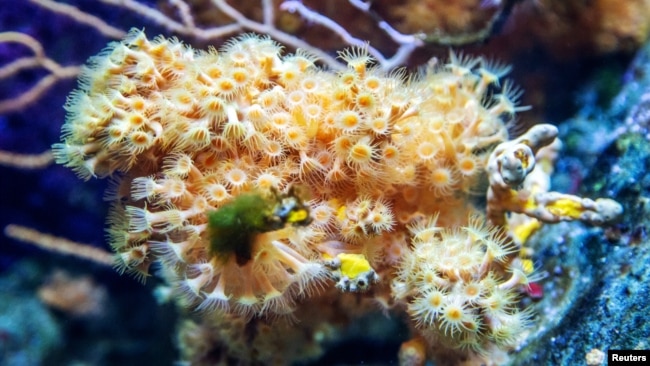サンゴ成分が癌に効く?!
25年以上にわた研究の末に見つけたその成分!!
興奮と驚きと期待でワクワクで鳥肌が立ちました!!
Awesome!!
VOAで英語学びましょう!!
がんに効くサンゴの成分を発見(和訳)
Scientists Discover Compound in Corals Shown to Fight Cancer
53 minutes ago
研究者たちは、サンゴに含まれる化学物質が癌治療に有効であることを発見したと発表しました。
科学者たちは、1990年代の初期の研究で、この化合物が癌細胞の成長を遅らせる可能性が示唆された後、25年以上にわたってこの化合物を探していました。研究者はついに、米国フロリダ州沖の一般的なソフトコーラルの一種からその物質を発見したのです。
ユタ大学の研究チームがこの発見を確認しました。同チームは、今回の成果により、この物質を抗がん剤に使用するために広く生産することが可能になると言います。
研究チームはこのほど、この発見をNature Chemical Biology誌の研究論文に記載しました。
米国海洋大気庁(NOAA)の報告によると、天然物質を病気の治療に利用することは新しいことではないとしています。海の生物、ヘビ、クモなど、あらゆる種類の生物から得られる化合物は、多くの健康状態に対する治療法の可能性として、長い間研究・試験が行われてきました。
多くのサンゴは一箇所に留まっているため、サンゴを脅かす他の海洋生物から身を守るために化学的防御を発達させてきたとNOAAは報告しています。科学者たちは、このような化学物質を研究して、効果的な医療用途を見つけようとしています。
しかし、このような研究の大きな障壁となっているのが、効果的な研究を行うために十分な量の化学物質を集めることが難しいという点です。
今回の研究で使用された化学物質は、エレウテロビンと呼ばれるものです。この化学物質は、オーストラリア付近のソフトコーラルから発見されました。1990年代に、この化学物質には癌と闘う性質があることが報告されています。
この研究に携わった研究者たちは、この化学物質が重要な細胞構造の破壊に一役買っていると述べています。ソフトコーラルは捕食者に対する防御としてこの化学物質を使用します。しかし、科学的な研究では、この化合物は癌細胞の成長を抑制する可能性があることも示唆されています。
この研究により、科学者たちは、追加試験や新しい抗がん剤の開発に必要な大量の化学物質を探し続けることになりました。しかし、そのような努力は何年経っても報われませんでした。
そんな折、ユタ大学のポール・スケーザという科学者が、フロリダ沖の海で、エレウテロビンを含むソフトコーラルを発見したのです。
研究チームは、この化学物質がサンゴ自身で作られたものなのか、それともサンゴの中に住む共生生物によって作られたものなのかを突き止めようとしたのです。スケーザ氏は、この化合物が他の生物によってのみ生産されるというのは”腑に落ちない”と声明で述べています。
例えば、ソフトコーラルの中には共生生物を持たないのに、同じ化学物質の集合体を体内に持つものがあることを、研究チームは知っていました。
そこで研究チームは、サンゴがどのように化合物を生成しているのかを調べようとしました。そのためには、サンゴの遺伝暗号を調べて、その中に化学物質の生成方法が含まれているかどうかを調べる必要がありました。
この作業は、生物のDNAを研究する現代の手法によって可能になりました。DNAはほぼすべての生物に存在し、遺伝情報を担っています。
しかし、化学物質を作るための指示書がどのようなものであるかが分からないため、次のステップは困難でした。
しかし、サンゴのDNAから、他の生物種の類似化合物の遺伝子の指示と非常に近い部分を特定することができたと報告されました。そして、その指示書を実験室内で培養したバクテリアに与えることができました。研究チームは、このバクテリアの微生物が、エレウテロビンの生成の最初のステップをコピーすることができたと報告しています。
「これは、地球上のあらゆる薬物のリードで初めて可能になったことです 。」と、主任研究者のエリック・シュミッツ氏は語ります。彼はユタ大学ヘルス校の医薬品化学の教授です。
研究者たちは、今回の実験によって、この化学物質を実験室で製造することが可能であることが実証されたと述べています。これは新しい抗癌剤を広く生産する可能性につながるものです。
スケーザ氏は、いつかこの薬を医者に渡せるようになりたいと言っています。「海の底からベンチ、ベッドサイドに行くようなものだと考えています。」と彼は言っていました。
Scientists Discover Compound in Corals Shown to Fight Cancer
Researchers say they have discovered a chemical found in sea corals that could be effective in treating cancer.
Scientists had been searching for the compound for more than 25 years after early studies in the 1990s suggested it could slow cancer cell growth. A researcher finally discovered the substance in a common kind of soft coral off the coast of the American state of Florida.
A research team from the University of Utah has confirmed the discovery. The team said their results could lead to widespread production of the substance for use in cancer drugs.
The researchers recently described their findings in a study in the publication Nature Chemical Biology.
The use of natural substances to treat disease is not new, the U.S. National Oceanic and Atmospheric Administration (NOAA) reports. Compounds from all kinds of organisms – including sea life, snakes, spiders and other animals – have long been studied and tested as possible treatments for many health conditions.
Since many corals stay in one place, they have developed chemical defenses to protect against other forms of sea life that could threaten them, NOAA reports. Scientists study such chemicals in an effort to find effective medical uses.
But a major barrier to these efforts has been the difficulty of gathering enough of these compounds to carry out effective research.
The chemical used in the latest study is called eleutherobin. It was discovered in soft corals near Australia. Scientists reported in the 1990s that the chemical had cancer-fighting properties.
Researchers involved in the study said the chemical can play a part in breaking down important cell structures. It is used by soft corals as a defense against predators. But scientific studies have suggested the compound also shows promise in reducing cancer cell growth.
The studies led scientists to keep searching for large amounts of the chemical that would be necessary to carry out additional testing and possibly develop new cancer drugs. But those efforts were unsuccessful for many years.
Then, a scientist working on the University of Utah team, Paul Scesa, found a soft coral in the ocean off the Florida coast that contained eleutherobin.
The team sought to find out whether the corals made the chemical themselves or whether it was produced by symbiotic organisms living inside the corals. Scesa said in a statement it did not “make sense” to him that the compound would only be produced by other organisms.
His team knew, for example, that some soft corals do not have symbiotic organisms and yet their bodies contain the same collection of chemicals.
To test their theory, the researchers attempted to find out how the corals were producing the compound. To do this, they needed to study the corals’ genetic code to learn whether it included instructions on how to produce the chemical.
This process is possible through modern methods for studying the DNA of organisms. DNA is present in nearly all living things and is the carrier of genetic information.
The next step was difficult because the scientists did not know what the instructions for making the chemical should look like.
But they reported they were able to identify parts of DNA in the coral that were very close to genetic instructions for similar compounds in other species. They were then able to provide those instructions to bacteria grown inside a laboratory. The team reported that the bacterial microorganisms were able to copy the first steps of making eleutherobin.
“This is the first time we have been able to do this with any drug lead on Earth,” said lead researcher Eric Schmidt. He is a professor of medicinal chemistry at the University of Utah Health.
The researchers say their experiments demonstrated that it should be possible to manufacture the chemical in the laboratory. This could lead to possible widespread production of new anti-cancer drugs.
Scesa said he hopes to one day be able to hand over the medicine to a doctor. “I think of it as going from the bottom of the ocean to bench to bedside,” he said.
Words in This Story
coral – n. a hard or soft, usually pink or white substance produced by a type of very small sea animal
predator – n. an animal that hunts and kills other animals for food
symbiotic – adj. involving two kinds of animal or plant in which each provides the conditions necessary for the other to exist
genetic code –n. information from DNA or RNA that is used to create an organism's proteins
species – n. a group of animals or plants that are similar and can produce young animals or plants
bench – n. a long table for doing work on
